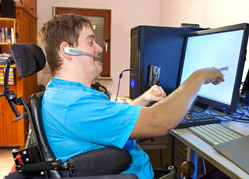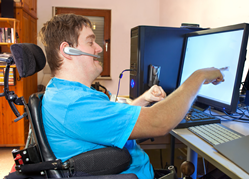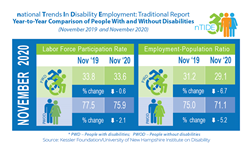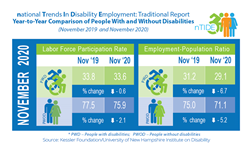“As predicted last month, we see declines in the employment-to-population ratio this month as COVID-19 infections have increased during the fall and federal aid has yet to be renewed,” said John O’Neill, PhD, director of the Center for Employment and Disability Research at Kessler Foundation.
EAST HANOVER, N.J. (PRWEB)
December 04, 2020
Kessler Foundation and University of New Hampshire nTIDE Report—featuring A Little Something Extra Ice Cream, a family-owned business in Alabama run by young adults with disabilities
Americans with disabilities remained engaged in the labor force, according to today’s National Trends in Disability Employment – Monthly Update (nTIDE), issued by Kessler Foundation and the University of New Hampshire’s Institute on Disability (UNH-IOD). Experts expressed guarded optimism as all workers face the uncertain prospects of more federal aid and the effects of the ongoing COVID-19 pandemic.
nTIDE COVID Update (month-to-month comparison)
In the Bureau of Labor Statistics (BLS) Jobs Report released Friday, the employment-to-population ratio for working-age people with disabilities decreased slightly from 29.2 percent in October to 29.1 percent in November 2020 (down 0.3 percent or 0.1 percentage points). For working-age people without disabilities, the employment-to-population ratio also decreased slightly from 71.3 percent in October to 71.1 percent in November 2020 (down 0.3 percent or 0.2 percentage points). The employment-to-population ratio, a key indicator, reflects the percentage of people who are working relative to the total population (the number of people working divided by the number of people in the total population multiplied by 100).
“As predicted last month, we see declines in the employment-to-population ratio this month as COVID-19 infections have increased during the fall and federal aid has yet to be renewed,” said John O’Neill, PhD, director of the Center for Employment and Disability Research at Kessler Foundation. “Let’s hope that we see employment improve after the New Year as the COVID-19 vaccine becomes more widely available,” he added.
The labor force participation rate for working-age people with disabilities increased slightly from 33.3 percent in October to 33.6 percent in November 2020 (up 0.9 percent or 0.3 percentage points). For working-age people without disabilities, the labor force participation rate decreased from 76.2 percent in October to 75.9 percent in November 2020 (down 0.4 percent or 0.3 percentage points). The labor force participation rate is the percentage of the population that is working, not working and on temporary layoff, or not working and actively looking for work.
“For people with disabilities, the labor force participation rate showed a small gain compared to last month and is only slightly below this time last year,” noted economist Andrew Houtenville, PhD, research director of the University of New Hampshire’s Institute on Disability. “This is good news long-term and suggests people with disabilities are staying engaged in the workforce by either working, actively looking for work, or are still expecting to be recalled. With employment increasing, this improvement also signals that people with disabilities are entering or reentering the labor force, possibly responding to family needs as other family members lose their jobs. It will be important to track this indicator as economic restrictions are reinstated to combat the increasing spread of COVID-19.”
Traditional nTIDE Numbers (comparison to the same time last year)
The employment-to-population ratio for working-age people with disabilities decreased from 31.2 percent in November 2019 to 29.1 percent in November 2020 (down 6.7 percent or 2.1 percentage points). For working-age people without disabilities, the employment-to-population ratio also decreased from 75 percent in November 2019 to 71.1 percent in November 2020 (down 5.2 percent or 3.9 percentage points).
The labor force participation rate for working-age people with disabilities decreased from 33.8 percent in November 2019 to 33.6 percent in November 2020 (down 0.6 percent or 0.2 percentage points). For working-age people without disabilities, the labor force participation rate also decreased from 77.5 percent in November 2019 to 75.9 percent in November 2020 (down 2.1 percent or 1.6 percentage points).
In November 2020, among workers ages 16-64, the 4,409,000 workers with disabilities represented 3.1 percent of the total 139,998,000 workers in the U.S.
Beyond the Numbers
Families with children with disabilities often face challenges while planning for the future. Many times the family’s ultimate goal is to help their child gain maximal independence and optimal quality of life. Some families choose the pathway to entrepreneurship, opting to start a business centered on their child’s skills and interests. The impact of these enterprises can extend beyond the family and the individual with disabilities, reaching local communities and beyond. One example of a successful family enterprise is ‘A Little Something Extra’ in rural Dawson, Alabama.
Founded by the Norwood family, ‘A Little Something Extra’ is an ice cream truck that has become a familiar sight at local events. The truck is staffed by CEO Hunter Norwood, 19, who has Down syndrome, and his peers with disabilities from the local area. Michelle Norwood, Hunter’s mother, came up with the business concept. Michelle is a special education teacher, a career path inspired by Hunter’s disability. Concerned about the lack of job opportunities in their rural hometown, Michelle was attracted to the idea of creating a business that could employ Hunter, as well as her special education students after graduation.
On a family trip to Memphis, she noticed the popularity of the neighborhood ice cream truck, something the small town of Dawson did not have. That was the start of ‘A Little Something Extra’, a reference to the extra chromosome 21 that characterizes Down syndrome. The start-up was a success, with the truck in demand by healthcare facilities, churches, and businesses, and at parades, festivals, and other events. The Norwood’s success has extended to other in the community. More than 20 young adults with disabilities have trained as ‘ice cream experts’ for this unique business, which Michelle also sees as a tool for promoting advocacy and awareness of people with disabilities.
“Entrepreneurship offers a pathway for families like the Norwoods to ensure a place for their adult offspring in the workforce, where they can work toward self-sufficiency on their own terms,” noted Elaine E. Katz, MS, CCC-SLP, senior vice president of grants and communications at Kessler Foundation. “The success of ‘A Little Something Extra’ shows how the benefits of entrepreneurship extend beyond the direct economic benefits for individuals with disabilities. This underscores the importance of having policies and programs that support disability-owned businesses and maximize the potential for job growth in this area.
nTIDE COVID Update – Friday, December 18 at 12:00 pm Eastern
Stay tuned for our mid-month update about the employment of people with disabilities as we follow the impact of COVID-19 and look at the numbers in more detail.
Ask Questions about Disability and Employment
Join our nTIDE Lunch & Learn series today, December 4, at 12:00 pm Eastern. This live broadcast, hosted via Zoom Webinar, offers attendees Q&A on the latest nTIDE findings, provides news and updates from the field, as well as invited panelists to discuss current disability-related findings and events. Today, Michelle and Hunter Norwood from ‘A Little Something Extra’ in Dawson, Alabama, join Dr. Houtenville, Dr. O’Neill, and Denise Rozell, Policy Strategist at AUCD. Join live or watch the recordings at: ResearchonDisability.org/nTIDE.
NOTE: The statistics in the nTIDE are based on Bureau of Labor Statistics numbers but are not identical. They are customized by UNH to combine the statistics for men and women of working age (16 to 64). nTIDE is funded, in part, by grants from the National Institute on Disability, Independent Living and Rehabilitation Research (NIDILRR) (90RT5037) and Kessler Foundation.
About Kessler Foundation
Kessler Foundation, a major nonprofit organization in the field of disability, is a global leader in rehabilitation research that seeks to improve cognition, mobility, and long-term outcomes — including employment — for people with neurological disabilities caused by diseases and injuries of the brain and spinal cord. Kessler Foundation leads the nation in funding innovative programs that expand opportunities for employment for people with disabilities. For more information, visit KesslerFoundation.org.
About the Institute on Disability at the University of New Hampshire
The Institute on Disability (IOD) at the University of New Hampshire (UNH) was established in 1987 to provide a coherent university-based focus for the improvement of knowledge, policies, and practices related to the lives of persons with disabilities and their families. For information on the NIDILRR-funded Employment Policy and Measurement Rehabilitation Research and Training Center, visit ResearchonDisability.org.
For more information, or to interview an expert, contact:
Carolann Murphy, 973.324.8382, CMurphy@KesslerFoundation.org














